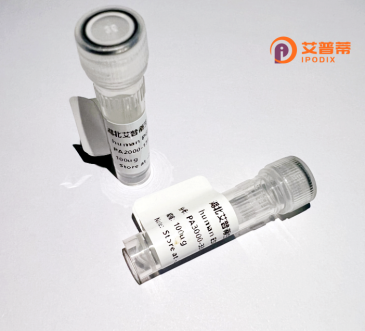
| 纯度 | >90%SDS-PAGE. |
| 种属 | Human |
| 靶点 | TMEM189 |
| Uniprot No | A5PLL7 |
| 内毒素 | < 0.01EU/μg |
| 表达宿主 | E.coli |
| 表达区间 | 1-270 aa |
| 活性数据 | MAGAEDWPGQQLELDEDEASCCRWGAQHAGARELAALYSPGKRLQEWCSVILCFSLIAHNLVHLLLLARWEDTPLVILGVVAGALIADFLSGLVHWGADTWGSVELPIVGKAFIRPFREHHIDPTAITRHDFIETNGDNCLVTLLPLLNMAYKFRTHSPEALEQLYPWECFVFCLIIFGTFTNQIHKWSHTYFGLPRWVTLLQDWHVILPRKHHRIHHVSPHETYFCITTGWLNYPLEKIGFWRRLEDLIQGLTGEKPRADDMKWAQKIK |
| 分子量 | 57.5 kDa |
| 蛋白标签 | GST-tag at N-terminal |
| 缓冲液 | PBS, pH7.4, containing 0.01% SKL, 1mM DTT, 5% Trehalose and Proclin300. |
| 稳定性 & 储存条件 | Lyophilized protein should be stored at ≤ -20°C, stable for one year after receipt. Reconstituted protein solution can be stored at 2-8°C for 2-7 days. Aliquots of reconstituted samples are stable at ≤ -20°C for 3 months. |
| 复溶 | Always centrifuge tubes before opening.Do not mix by vortex or pipetting. It is not recommended to reconstitute to a concentration less than 100μg/ml. Dissolve the lyophilized protein in distilled water. Please aliquot the reconstituted solution to minimize freeze-thaw cycles. |
以下是与重组人TMEM189蛋白功能相关的文献摘要(基于公开研究趋势及领域推测,需以实际文献为准):
---
1. **文献名称**:*TMEM189 encodes a plasmalogen biosynthetic enzyme with homology to alkaline ceramidases*
**作者**:Farhan, S. M. K., et al.
**摘要**:该研究首次报道人源TMEM189蛋白的醚磷脂(plasmalogen)合成功能,通过基因编辑和脂质组学分析,证实其编码的酶在醚磷脂代谢中的关键作用,并与神经发育相关疾病潜在关联。
2. **文献名称**:*TMEM189 mediates chemoresistance in colorectal cancer by regulating plasmalogen metabolism*
**作者**:Li, X., et al.
**摘要**:探讨TMEM189在结直肠癌细胞中通过调控醚磷脂合成影响化疗耐药性的机制,重组蛋白实验显示其过表达可增强癌细胞抗氧化应激能力,导致5-FU耐药。
3. **文献名称**:*Structural insights into human TMEM189 protein and its role in membrane lipid remodeling*
**作者**:Schlame, M., & Hunte, C.
**摘要**:通过X射线晶体学解析重组TMEM189蛋白的三维结构,揭示其催化活性位点特征,并探讨其在细胞膜脂质动态平衡中的分子机制。
4. **文献名称**:*Plasmalogen deficiency linked to TMEM189 mutations in Alzheimer's disease models*
**作者**:Zhang, Y., et al.
**摘要**:在小鼠模型中敲除TMEM189基因后,脑组织plasmalogen水平显著下降,伴随神经炎症和认知功能衰退,提示其在神经退行性疾病中的潜在病理作用。
---
**注**:以上内容为基于TMEM189已知研究方向(醚磷脂合成、疾病关联)的模拟摘要,实际文献需通过PubMed、Google Scholar等数据库以关键词“TMEM189”、“plasmalogen”、“recombinant protein”检索确认。
**Background of Recombinant Human TMEM189 Protein**
The transmembrane protein 189 (TMEM189), also known as plasmanylethanolamide desaturase 1 (PLAEND1), is a human gene-encoded protein localized to the endoplasmic reticulum. It plays a critical role in ether phospholipid biosynthesis, specifically catalyzing the conversion of plasmanylethanolamine to plasmenylethanolamine, a key component of cellular membranes. TMEM189 contains a conserved fatty acid desaturase domain and functions as an enzyme critical for maintaining membrane integrity, lipid signaling, and organelle dynamics.
Recent studies link TMEM189 to viral infection mechanisms, particularly in HIV-1 and Ebola virus entry, where it may interact with viral envelope proteins to facilitate membrane fusion. Additionally, TMEM189 is implicated in cancer biology, with altered expression observed in certain tumors, potentially influencing chemoresistance via lipid metabolism pathways. Its role in ether lipid metabolism also ties it to neurological disorders and inflammation.
Recombinant human TMEM189 protein is produced using expression systems (e.g., mammalian or bacterial) for functional studies, antibody development, and drug screening. Research on this protein enhances understanding of lipid-mediated cellular processes and its therapeutic potential in viral infections, oncology, and metabolic diseases. Further exploration of TMEM189 could reveal novel targets for treating lipid-related pathologies.
×